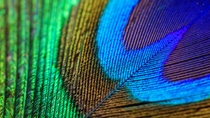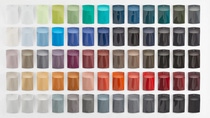Media
Structural color - mimicking the brilliance of nature

The brilliant-blue feathers of a kingfisher, iridescent hues of butterfly wings, and metallic shimmering chitin covers of beetles – these examples of natural beauty are based on structural color. Mimicking them is both a desire and a huge challenge for chemical manufacturers, as the structures are complex. Dr. Rupa Darji, a BASF research manager, along with her team, collaborated with academics from Harvard University to fundamentally understand structural color and how it can enable further application in an industrial setting. Rupa has been an industrial scientist for more than 15 years.
What’s your job about? What kind of scientist are you?
As part of the Advanced Materials & Systems Research Division, I support BASF’s businesses by solving many diverse technical challenges and problems. My team provides insight into emerging research on formulation and evaluates and implements new technologies. I'm a solid-state chemist by training and am responsible for managing and leading research projects for new types of products that create value for multiple businesses at BASF. I really enjoy bringing people of different scientific disciplines together to solve a challenge that has meaning for all of us. Though we work on both short-term and long-term projects, I am most excited by long-term innovations that can impact science, society, and the environment.
What is structural color and what is your research about?
Structural color is different than other traditional colorants like dyes or pigments. While these are mostly based on the absorption of light, structural color is based on the scattering of light. It is color derived from micron and submicron structures that reflect specific wavelengths of light. Unlike organic-based dyes and pigments, inorganic-based structural color does not fade. Structural color is found in nature, giving many species of birds, insects, and certain gemstones their vibrant color schemes. Industry tries to mimic structures found in nature to apply in their applications. However, such structures are complex and reproducing them is complicated and time-consuming. This motivated us to find a way for BASF to mimic the color brilliance of nature in a more efficient and economical way.
Working in this research area has changed my appreciation for both color and nature.
Why are structural colors interesting for BASF?
There are several reasons why structural color is so interesting. As scientists, we are always looking for new ways to improve the stability of traditional colorants that can degrade and fade over time. In contrast, inorganic-based structural color will not fade. Additionally, they offer great opportunities to create new appealing optical effects that have not been created before with traditional colorants. For example, both angle-independent and angle-dependent colors are difficult to make with traditional pigments. Angle-independent means that the color does not change at any observation angle. With angle-dependent colors, in contrast, the appearance changes depending on observation angle – which is an appealing feature for cosmetics.
.png)
How did Harvard get involved in the project?
At BASF, we have a lot of expertise in chemistry and engineering. Since structural color really depends on light and how it reflects from its structures, we needed some help to better understand the physics. Fortunately, I found a professor at Harvard’s engineering school who understands the fundamentals and physics of structural color. His lab offered to create a digital model that could predict what kinds of colors can be made based on the structural features of materials. Basically, the collaboration involved Harvard creating these models while we did the experimental work at BASF. We worked in parallel – learning together was key. As a result, jointly exploring this new area of structural color research was a rewarding experience.
How did the project change the work on structural color for BASF?
There are many applications where structural color could be used. They provide value for multiple businesses. Thanks to the collaboration with Harvard, we now have a model that can predict the color based on formulation and design. This saves BASF time and effort when we design materials for an application. It also helps our businesses utilize structural color in their formulations and products. Due to its versatility, structural color can be used in many ways, especially to ensure long-lasting colors for applications ranging from coatings to cosmetics.
What’s your favorite color?
I used to have a favorite color, but now I look at colors differently. Today, I have an appreciation for many colors, because each one is special and difficult to make. When traveling with family and friends, I’ve learned how other countries and cultures have uniquely applied color in their daily lives, which has opened my perspective. So, working in this research area has changed my appreciation for both color and nature.
For media inquiries and questions, please contact: katharina.meischen@basf.com.
